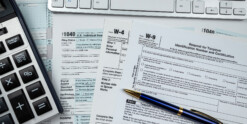Closing Out 2Q 2014
Economic Activity
Economic data improved during the second quarter after a weather-dampened Q1.
– Confidence saw mixed results with all the readings this quarter. The mixed readings seem to suggest a semi-nervous investor.
The Good: The Conference Board’s sentiment reading continued to advance.
The Boring: The Bloomberg consumer comfort reading saw a revision to its calculation and stayed flat for most of the quarter.
The Bad: University of Michigan reading on consumer sentiment fell 1.9% during the quarter.
– Housing had a real weak start to the year due to weather, but the industry seemed to pick up during the recent quarter.
The Good: Existing home sales increased to 4.89 million. Housing starts were up 5.8%. New home sales were up 31% during the quarter. Pending home sales were better on a month-overmonth basis. Home prices continued to increase within the 20 city index.
The Boring: Building permits stayed flat, ending the quarter at 991K.
The Bad: Mortgage apps struggled in what has historically been a strong housing season.
– Inflation remains a minimal concern. But more attention continues to shift to the “what ifs” in regards to Fed policy and future inflation.
The Good: PMI continued to increase (rising 4.8%). PPI ex food & energy outpaced expectations in two of three monthly readings during the quarter.
The Boring: Core CPI rose 0.5% during the quarter. From month to month, PCE was unchanged.
– Manufacturing rebounded in Q2 with both ISM readings clicking back above the important 55 level, suggesting growth in each sector.
The Good: ISM manufacturing moved back above 55 to end the quarter at 55.4. Nonmanufacturing also had a good quarter moving higher by 6% to finish at 56.3.
The Boring: Capacity utilization was flat, ending the quarter at 79.1%.
– Employment continued to show positive headline numbers. The economy is waiting to see the positive numbers filter into economic growth.
The Good: ADP numbers continued to increase. Non-farm payroll numbers advanced more than expected. Private payrolls reached nearly 300K. The underemployment rate dropped to 12.1% in June. The unemployment rate dropped to 6.1% in the June reading.
The Bad: The labor force participation rate remained at 62.8% for the majority of the quarter.
Equity Activity
Equity markets continued to prod along in the second quarter, continuing momentum that they had towards the end of Q1.
– To begin the quarter, the NASDAQ suffered its worst day in 2.5 years.
– Apple announced and executed a 7 for 1 split.
Also, Apple announced the acquisition of trendy headphone company Beats for nearly $3 billion.
– Sprint and T-Mobile moved closer to finalizing its $32 billion merger.
– AT&T moved to stay up with the Joneses and agreed to buy Direct TV for $49 billion.
– Civil war continues in Iraq with the ISIS trying to take over many Iraqi cities.
– The Obama administration agreed to allow for oil to be exported on the heels of crisis in the Middle East.
– Intel was the Dow’s best performer last quarter advancing 19.72%.
Pfizer was the index’s worst performer falling 7.60%.
– Performance for the quarter through 3-31-2014:
Dow up 2.84%, S&P up 4.49%, NASDAQ up 3.60%
10-year Treasury yield fell 19bps to 2.53%
GLD up 3.77% and OIL up 8.85%
Storylines: The Past & Future
Gross Disgusting Product… GDP disappoints
It just kept getting worse with every revision. The first reading on Q1 GDP came in poor and by the end of the revisions Q1 GDP dropped 2.9%. Now, weather was definitely a major cause, but the extent of the weakness was worse than expected. Q2 GDP will need to see a pop to give investors some comfort that Q1 was truly just a small blip on the radar.
S&P hits mark not seen since 1998
With the positive return on the S&P during Q2, the index hit a mark we haven’t seen in over 15 years. This quarter’s positive return meant that we have now seen six straight quarters of positive returns in the S&P. In the second quarter of 1998, we experienced 14 straight winning quarters. The 90s was a major bull rally that many don’t believe we can experience again. But despite the naysayers with regards to this current rally, what we are experiencing now may become very similar to the strong bull we saw in the 1990s.
Small caps enter & exit correction territory…in a day
The Russell 2000 index (small caps) spent a very brief moment in correction territory during Q2. From peak (which started in Q1) to trough, the index fell 10% (intraday) in the last quarter. Small caps had been handily outperforming the mid and large cap companies. Despite the sharp fall during the quarter, small caps staged a strong rally to end the quarter. But the rally wasn’t enough to overtake mid caps which saw the best returns amongst its peers (small and large caps).
Utilities soar
The defensive sector was the best performing sector for the first half of 2014. It’s not too shocking given investors’ tepidness entering the year. As investors wanted exposure to equities, but given the returns in 2013 many investors were afraid. Thus utilities make a whole lot of sense for those individuals. The energy sector was behind utilities and could eclipse the defensive sector during the second half of the year if Middle East turmoil persist and oil prices continue to move higher.
Q3… A time to breathe
Well, that’s at least what history tells us. Going back to 1928, we have seen Q3 provide investors with the lowest returns in the S&P. The average performance for the S&P in Q3 is a gain of 1.3%. Along with the seasonal headwinds, it’s mid-term elections year. Q3 returns don’t tend to fare too well during mid-term years. July tends to see an average return of 0.6%, while August and September average 0.6% and 1.2% declines, respectively. It looks like Q3 would be a good entering point for some of those investors on the sidelines that want equity exposure. Q4 tends to fare much better on both a seasonal and mid-term election cycle basis.
The Final Word
I think that many investors are surprised by the markets during the first half of the year. We have long term bonds providing the best returns and equity markets continuing to advance after the large rally in 2013.
It was a foregone conclusion that yields were going to spike this year and markets were going to correct. This hasn’t happened, but I would also argue that markets really haven’t roared either.
I mean, does anyone really feel like the S&P is up over 7% on the year? Nope. The market has just prodded along and seemingly moved higher.
Focus tended to be on ISIS and the political issues with Obama’s executive orders and Cantor losing during the primaries, along with the ongoing issues with Ukraine and Russia.
This idea of markets just prodding along and advancing over 7% can serve as a reason to worry. But, companies continue to be in good shape with sound financials and lots of cash.
The wild card continues to be the Fed and how they exit the marketplace and begin raising rates. But given the valuations many equities have, the downside to mistakes from the Fed seems to be ones that would be short-lived. Because markets don’t need to correct too much before many household names would be screaming buys.
On the other hand, fixed income will remain needed (maybe not desirable) given our aging population and continue global unrest.
So, despite the worries that continue to persist in the markets along with the somewhat surprising first half, markets continue to provide opportunities. The opportunities aren’t screaming like they were in past years, but this continues to be reason why a diverse portfolio is needed more than ever.













